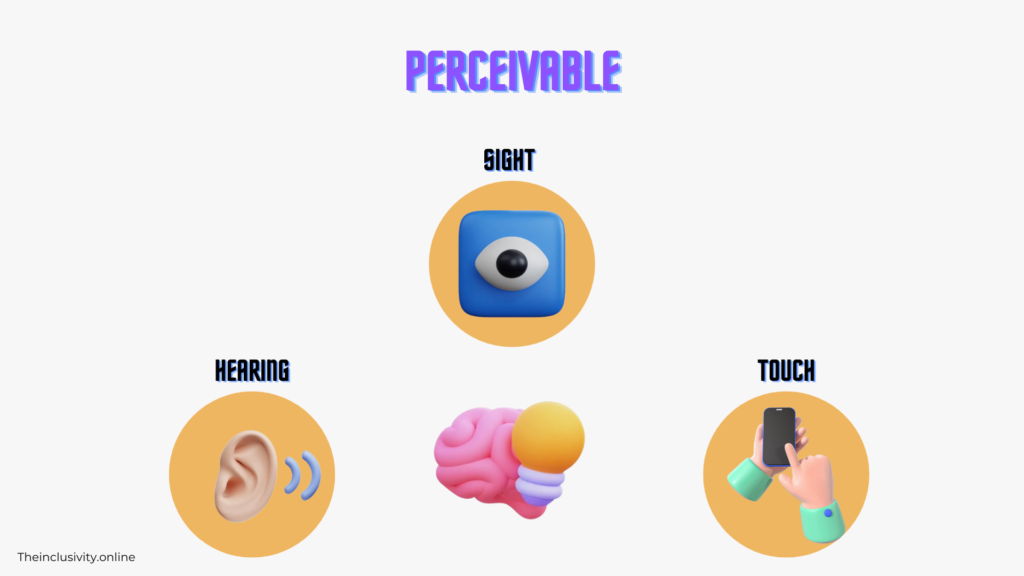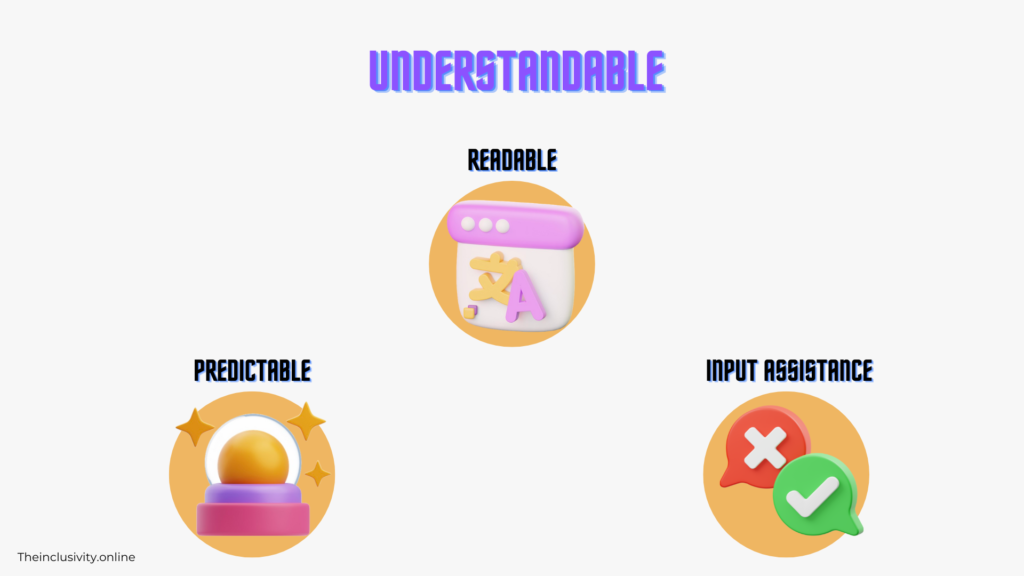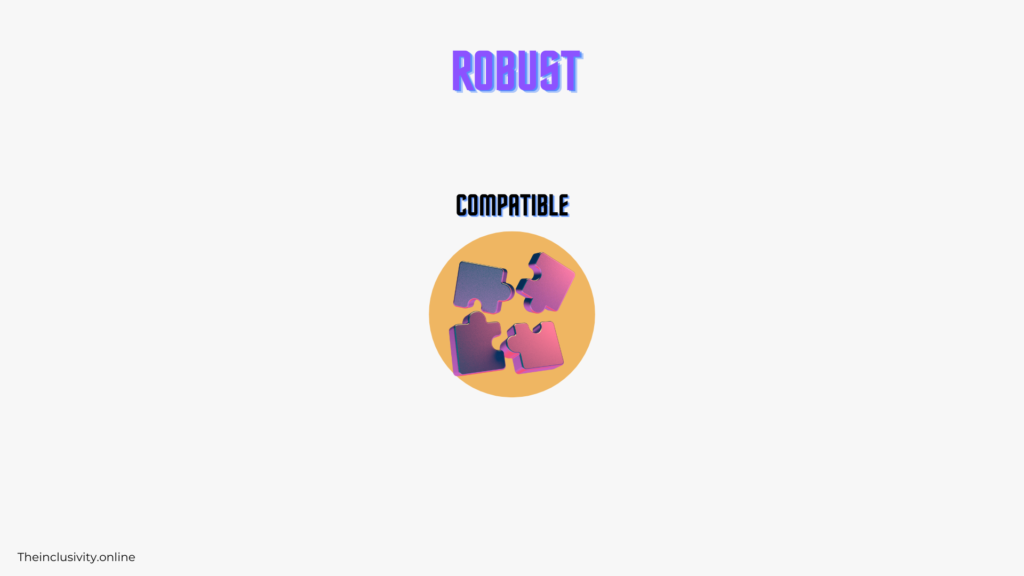|
Getting your Trinity Audio player ready... |
Welcome back! Today, we’re diving headfirst into our WCAG series(missed the intro? Catch it here) with a no-nonsense look at the core of accessibility: the POUR Principles. These principles are your blueprint for making web content accessible to everyone—yes, everyone.
While the POUR principles lay down a solid foundation for inclusive design, there’s an ugly truth no one wants to talk about. A shocking 67% of accessibility issues happen in the design phase. Designers, we’re not throwing shade—but, well, we’re sort of looking in your direction. 😬 (For more on that stat, check out this insightful read.)

Ok, now let’s break down each of the POUR principles to see how they can make your designs more inclusive.
P: Perceivable: Making Content Available to the Senses 👀
if users can’t see or hear your content, they can’t access it. It’s as simple as that. The perceivable principle is all about ensuring that your information is available to everyone. This means text alternatives for images, captions for videos, and audio descriptions. If your content isn’t accessible to all senses, you might as well be speaking into a void. So, step it up and make sure everyone can follow along!

Examples:
Captions & Transcripts: If you have a video on your site, add captions so people who are deaf or hard of hearing can follow along. And don’t forget about transcripts for podcasts or audio content—these are crucial for everyone, including those who prefer reading to listening.
Color Contrast: I can’t stress this enough: your colour palette and brand identity might be eye-catching, but if they’re inaccessible, they’re worthless. If text blends into the background, users with low vision or colour blindness will struggle to read it. Ensure there’s a strong contrast between text and background colour, or you’re just creating barriers.
Alternative Text: Descriptive alt text for images isn’t just a nice-to-have; it’s a must. This helps screen readers convey the content of images to users who can’t see them. Don’t skip this step—it’s essential for inclusivity.
Why it’s important: Picture someone with low vision trying to decipher light gray text on a white background. If the text isn’t easy to perceive, they’re locked out of your content.
💡Tip for Designers:
- Visual Hierarchy: Use visual hierarchy to guide users through your content. Clear headings and subheadings help users with cognitive impairments navigate and understand what they’re reading. Don’t underestimate the power of good organization.
💡Tip for Developers:
- Accessible ARIA Roles:Implement ARIA roles to enhance the perceivability of dynamic content. For instance, using
aria-livefor live regions ensures screen readers announce updates in real time. This is how you keep users in the loop.
O: Operable: Ensuring Functionality for Every User 🕹️
Operability isn’t just a buzzword—it’s about making sure every user can navigate and interact with your website using various input methods, not just a mouse. Some users depend on keyboards, voice commands, or other assistive technologies to get things done. If your design doesn’t support these methods, you’re effectively shutting the door on a significant portion of your audience.

Examples:
Keyboard Navigation: Ensure that all interactive elements, like buttons, forms, and menus, are accessible via keyboard navigation. If users can’t tab through your site easily, they’ll bounce faster than you can say “accessibility fail.”
Avoiding Keyboard Traps: Have you ever tabbed through a webpage and got stuck in a dropdown or popup? That’s a keyboard trap! Ensure users can navigate through and away from any interactive elements without getting stuck.
Voice Commands: Optimize your site for voice commands. More users are relying on voice technology every day. If your website isn’t voice-friendly, you’re missing out on an opportunity to make it easier for everyone to access your content.
Touch Targets: Don’t make users play a game of precision to click your buttons. Touch targets need to be large enough for users to tap easily, especially for those with motor impairments.
Why it’s important: If a user can’t interact with your site because it’s not operable via their preferred input device, they’re blocked from using it.
💡Tip for Designers:
- Focus on Intuitive Navigation: Make your website’s navigation intuitive. Users shouldn’t have to guess where to click or how to get to the next page. A straightforward, logical structure helps everyone—especially those using assistive technologies.
💡Tip for Developers:
- Logical Tab Order: Ensure users can move through your site in a logical, hassle-free sequence. Implementing a proper tab index helps users navigate through forms and interactive elements efficiently.
U: Understandable: Clear and User-Friendly Content 🧠
Understandability is all about how easily users can comprehend the information and navigate your site. If your content is confusing, users will abandon ship faster than you can think. This principle covers everything from language clarity to design consistency.

Examples:
Language Clarity: Ditch the jargon and get to the point. Use simple, straightforward language that everyone can grasp. If you think your audience will understand technical terms or complex phrases, think again. Keep it clear and concise—no one’s got time for riddles.
Consistent Design: Consistency is your best friend when it comes to user experience. If buttons look different on every page or the navigation changes randomly, users will be left scratching their heads. Establish a design system that keeps elements uniform, so users know what to expect at every turn
Clear Instructions: Make sure instructions for forms or buttons are easy to spot. For example, if you want users to enter a password, make sure the instructions appear before the password field so that people using screen readers get the context first.
Why it’s important: If your site’s navigation or language is too complicated, people with cognitive disabilities or non-native speakers might struggle to interact with it. Accessibility isn’t just about compliance; it’s about ensuring everyone can engage with your content effortlessly.
💡Tip for Designers:
- Consistent Layout: Use a consistent layout throughout your site to help users with cognitive disabilities build a mental model of how to interact with your content.
💡Tip for Developers:
- Error Identification: Ensure that error messages are clear and provide actionable solutions. If something goes wrong, give users a clear roadmap to fix it.
R: Robust: Building Content that Stands the Test of Time 💪
Robustness is all about ensuring your content is compatible with various technologies, including both current and future assistive tools. This principle focuses on using valid, standardized code so your site functions smoothly across different browsers, operating systems, and devices

Examples:
Valid HTML & CSS: Make sure your code follows web standards so assistive tech can interpret it correctly.
Assistive Technologies: Tools like screen readers and keyboard-only navigation depend on well-structured code.
Future-Proofing: Technology isn’t static. As new devices and tools emerge, your site should be ready to adapt. Sticking to web standards today ensures that your site remains accessible tomorrow. If you neglect this, you risk your content becoming obsolete.
Why it’s important: A website built without future compatibility in mind can quickly become inaccessible as technology evolves. Are you prepared for that?
💡Tip for Designers:
- Future-Proof Design: Think ahead! Design with scalability in mind. Your layout should be flexible enough to adapt to different screen sizes and orientations, ensuring it’s ready for whatever the future throws at it.
💡Tip for Developers:
- Graceful Degradation: Implement graceful degradation so that your site remains functional even if certain modern features or technologies are not supported by older assistive technologies.
If you skip this post and stop here…
Whether you’re building a new site or tweaking an existing one, here’s how you can apply the POUR principles:
Perceivable: Ensure all content is accessible in multiple formats—visual, auditory, or tactile. If users can’t perceive it, they can’t access it. Simple as that.
Operable: Don’t just assume everyone uses a mouse. Make interactive elements navigable by keyboard, touch, or voice commands. If it’s not operable for all users, it might as well not exist.
Understandable: Keep your language simple and your navigation predictable. If users can’t understand your site, they won’t stick around. It’s that straightforward.
Robust: Use clean, standards-compliant code that works with assistive technologies and can handle future devices. If your code is a mess, don’t expect users to find their way around it.
So, there you have it—a straightforward guide to understanding WCAG through the lens of the POUR principles. Are you ready to make your website more accessible? Let’s put these principles into action!
Next Stop: Guidelines: The Goals (Jump to the post) 🎯